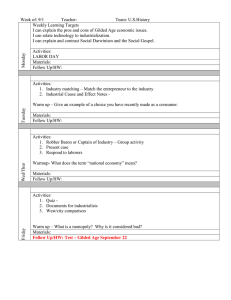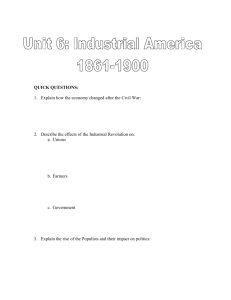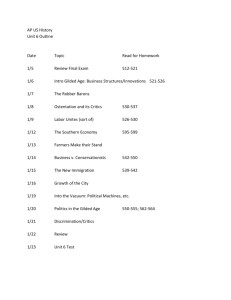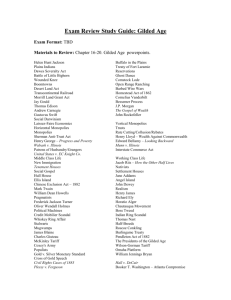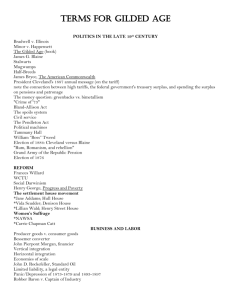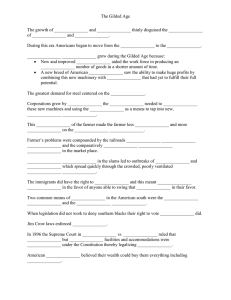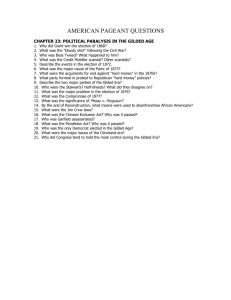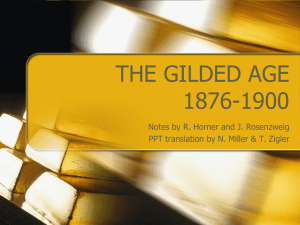Politics in a Gilded Age
advertisement
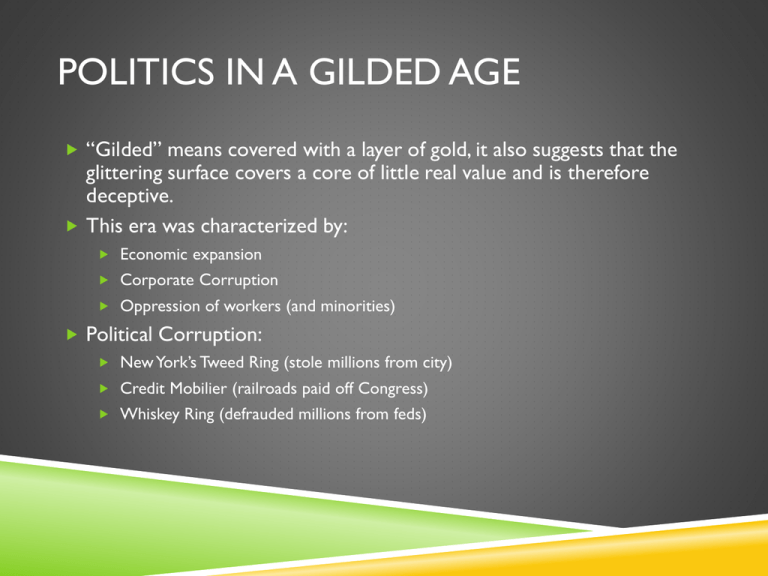
POLITICS IN A GILDED AGE “Gilded” means covered with a layer of gold, it also suggests that the glittering surface covers a core of little real value and is therefore deceptive. This era was characterized by: Economic expansion Corporate Corruption Oppression of workers (and minorities) Political Corruption: New York’s Tweed Ring (stole millions from city) Credit Mobilier (railroads paid off Congress) Whiskey Ring (defrauded millions from feds) WAS THE GILDED AGE POLITICAL SYSTEM EFFECTIVE IN MEETING ITS GOALS? Probably not Between 1876 and 1892 a political stalemate paralyzed the house, Senate Presidents made little effort to mobilize public opinion or exert executive leadership Federal Government did not deal with problems created by the economy’s rapid growth Local and state governments regulated education, medical care, business, civil/criminal prosecutions FEDERAL LEGISLATION High Tariff (tax on imported goods and services) Reduced Federal Spending Withdrew greenbacks (paper money in circulation) 1879-set the gold standard (which limited money in circulation to that which could be backed by gold in the US treasury Put banks in control of issuing money These policies favored big business and hurt Southern and Western farmers FEDERAL REFORMS 1883 Civil Service Act 1887 Interstate Commerce Commission (ICC) 1890 Sherman Antitrust Act-Tried to prohibit the creation of monopolies FREEDOM IN THE GILDED AGE Theory of Social Darwinism 1859-Darwin’s Origins of Species Theory of Natural Selection or survival of the fittest Interpreted as: Evolution was a natural process in human society as in nature, and governments must not interfere Deserving vs. Undeserving poor Modern rich elite vs. primitive poor WILLIAM GRAHAM SUMNER “Government existed only to protect the property of man and the honor of women, not to upset social arrangements decreed by nature.” p. 664 Government would not end “laissez faire” until FDR came to office PRINCIPLE OF NEGATIVE FREEDOM Favored limited government and unrestrained free market The principle of free labor, which originated as a celebration of the independent small producer in a society of broad equality and social harmony was translated into a defense of the unrestrained operations of the capitalist marketplace (p. 664) 14th Amendment was reinterpreted to defend the “right to labor” instead of equality for former slaves Lochner vs. New York voided state law that established a 10 hour day for bakers, said the law infringed on freedom of contract LABOR AND THE REPUBLIC 1877-Great Railroad strike, put down by feds Revealed worker solidarity Close ties between Republican party and industrialists Knights of Labor-800,000 members in 1886 Strikes, boycotts, political actions, education, social actions Membership rapidly grew in the next few decades See textbook for authors that criticized big business and sympathized with laborers: Henry George, L. Gronlund, E. Bellamy These works revealed a “wide spread consciousness that something is radically wrong with the present organization.” How would it be possible to protect the freedom of both industrialists and workers? LAISSAZ FAIRE ECONOMY Under attack by: Labor movements Authors Preachers Anarchists Strikes: Haymarket Affair, 1886 Homestead Strike, 1892 Coxey’s Army, 1894 Pullman Strike, 1894

